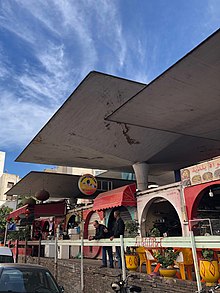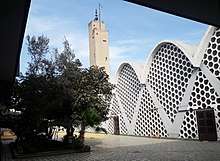Jean-François Zevaco
Jean-François Zevaco (Arabic: جان فرنسوا زيفاكو,1916–2003) was a French-Moroccan architect born in Casablanca.[1][2][3] He is considered an emblematic figure of the modernist architectural movement in Morocco and in Africa, and his legacy is important in terms of the number of constructions built across Morocco, the diversity of his works, and their international aura.
Jean-François Zevaco | |
|---|---|
| Born | 8 August 1916 |
| Died | 2003 |
| Education | École nationale supérieure des Beaux-Arts |
| Awards | Aga Khan Award for Architecture |
After his finishing his studies at the École nationale supérieure des Beaux-Arts in Paris and Marseille in 1945, he established a private practice in Morocco and started a career spanning from 1947 to 1999.[4] He marked the architecture of the second half of the 20th century with a resolutely modern work in intense dialogue with the country, the people, and the landscapes surrounding him.[5]
Biography
Zevaco was born in Casablanca on August 8, 1916 to a French family from Corsica.
Zevaco entered the National School of Fine Arts in Paris in 1937 where he joined the Pontrémoli-Leconte studio. He continued his studies in Marseille in the studio of Eugène Beaudoin during the Nazi occupation of northern France during World War II.
He returned to Casablanca after the war and opened a makeshift agency by occupying and arranging the veranda of the family house. He then settled with his partner Paul Messina at rue Bugeaud, and then opened his own agency at 7 Passage Sumica.
He began his career designing private villas such as Villa Suissa (1949), also known as "la Pagode," and Villa Gilardi (1949), with his collaborator Paul Messina.[6][7] Aziza Chaouni described this building as Zevaco's reaction to California modern architecture.
In contrast with post-war Europe, Casablanca was at midcentury an expanding town attracting investment from all over the world, a city in the midst of "euphoria" and a fertile field for architectural experimentation, which Zevaco fully embraced. His white villas with huge overhangs and incisive sunscreens were "scandalous" both for their contrast with the neo-Moorish architecture of the colonial administration and for the audacity and technical prowess in the use of concrete.[8]
In the early 1950s, he joined the Group of Moroccan Modern Architects (GAMMA)—the Moroccan branch of the International Congress of Modern Architecture (CIAM)—when it was created by Michel Ecochard. The GAMMA's activities would continue up until 1959.[9] Around this time, Zevaco built the Vincent Timsit Factory (1952) in the Roches Noires district in eastern Casablanca.[6]
_01.jpg)
After the Independence of the country, a continuity of language and discourse is indeed conveyed by many founding members of the group remained in Morocco and who defend a modernity based on a relationship to the local site and the climate. Against the current of international-type functionalism and like the post-war Brazilian or Mexican situated modernism, Zevaco produced a singular and Moroccan work, an architecture-sculpture sublimely innervated by the time and the space in which he evolves.[10]
In Tit Mellil, Zevaco designed the Casablanca Tit Mellil Airport (1953) with Dominique Basciano, and the Tit Mellil Rehabilitation Center (1960).[3]
Zevaco changed the landscape in Casablanca with his brutalist schools, such as the Théophile Gautier School (1960).[11][3]
Zevaco designed the Sidi Harazem Thermal Bath Complex, named after Ali ibn Harzihim, with brutalist architecture combined with local elements, such as blue zeliij and copper.[12]
He renovated United Nations Square in 1974 with his Kora Ardia (كرة أرضية Globe) underground passageway.[6]
Agadir reconstruction

Zevaco was a member of the Groupe des Architectes Modernes Marocains (GAMMA).[12] He worked with GAMMA colleagues, including Elie Azagury and Mourad Ben Embarek, in the reconstruction of Agadir after the 1960 earthquake.[12]
In 1965, Zevaco designed courtyard houses in Agadir that would later earn him an Aga Khan Award for Architecture.[13]
Latin American influences

Zevaco's Assuna Mosque in Casablanca, designed in a modernist style in the 1970s, drew inspiration from Oscar Niemeyer's Church of Saint Francis of Assisi in Pampulha, Belo Horizonte.[15] His Agadir Street Market (1975) draws from Pedro Ramírez Vázquez.[14] Zevaco was exposed to this architecture through L'Architecture d'Aujourd'hui, a French architecture magazine.
Awards
Jean-François Zevaco received the Aga Khan Award for Architecture in the 1978-1980 cycle for his 1965 Courtyard Houses in Agadir, Morocco.[16]
Main works
- Villa Suissa, Anfa, Casablanca, 1947
- Villa Craig, rue d’Auteuil, Casablanca, 1949
- Immeuble de la Société civile immobilière du centre, Rabat, 1949
- Airport, Tit Mellil, 1951
- Rehabilitation Center, Tit Mellil, 1953-1960
- Groupe scolaire, Agadir, Talborjt, 1955
- Infirmerie, Ben Slimane, 1956
- Tribunal, Mohammedia, 1958
- Tribunal, Ben Ahmed, 1958
- Gas station, Marrakech, 1958
- Groupe scolaire Georges-Bizet, Casablanca, 1960
- Thermal baths, Sidi Harazem, 1960
- Tribunal, Beni Mellal, 1960
- Siège social de la B.N.D.E., Rabat, 1962
- Caserne de pompiers, Agadir, 1963
- Post office, Agadir, 1963
- Maisons à patios, Agadir, 1964
- École des instituteurs, Ouarzazate, 1965
- Hôtel de ville, El Kelaa des Sraghna, 1967
- Hôtel Yasmina, Cabo Negro, 1968
- Villas en bande, Agadir, 1969
- Immeubles en bande, Agadir, 1969
- Villa Zniber, Rabat, 1970
- Agadir Street Market, Casablanca, 1972
- Underground walkway, United Nations Square, Casablanca, 1975
- Villa Zevaco, Casablanca, 1975
- Villa Ghissassi, Rabat, 1976
- Villa Zniber, Casablanca, 1988
- Villa Zniber, Marrakech, 1998,
Further reading
- Zevaco, by Michel Ragon and Henri Tastemain
- Transferts de modèles architecturaux au Maroc [Texte intégral], L’exemple de Jean-François Zevaco, architecte (1916-2003). Paru dans Les Cahiers d’EMAM, 20 | 2010, by Lucy Hofbauer https://journals.openedition.org/emam/82
- Le cas particulier des archives d’architectes : Histoires coloniales et histoires individuelles, l’architecture de Jean-François Zevaco dans le Maroc sous tutelle française. IRMC, 2013. Edition Karthala by Lucy Hofbauer
- L’architecture de tourisme au Maghreb : quelles relectures du patrimoine local ? Sous la direction de Charlotte Jelidi, Editions du Centre Jacques Berque, 2016 by Lucy Hofbauer
External links
- MAMMA.'s archives: Jean-François Zevaco
References
- HOFBAUER Lucy, 2006, Le modernisme syncrétique de Jean-François Zevaco (1916-2003), mémoire de Master 1, sous la direction de Jean-Baptiste Minnaert, Tours, Université François Rabelais.
- HOFBAUER Lucy, 2007, Jean-François Zevaco architecte (1916-2003) - villas, mémoire de Master 2, sous la direction de Jean-Baptiste Minnaert, Tours, Université François Rabelais.
- Dahmani, Iman; El moumni, Lahbib; Meslil, El mahdi (2019). Modern Casablanca Map. Translated by Borim, Ian. Casablanca: MAMMA Group. ISBN 978-9920-9339-0-2.
- Interview with Elie Azagury, by Aziza Chaouni in Journal of Architectural Education - Volume 68, 2014 - Issue 2 - Published online: 21 Sep 2017. https://www.tandfonline.com/doi/abs/10.1080/10464883.2014.943632
- Lucy Hofbauer, L’architecture de tourisme au Maghreb : quelles relectures du patrimoine local ? Sous la direction de Charlotte Jelidi, Editions du Centre Jacques Berque, 2016
- Cohen, Jean-Louis, author. Casablanca : colonial myths and architectural ventures. ISBN 1-58093-087-5. OCLC 49225856.CS1 maint: multiple names: authors list (link)
- Carayol, Sébastien (26 January 2018). "Casablanca: le labo Zevaco". Libération.fr (in French). Retrieved 12 May 2020.
- Lucy Hofbauer, Le cas particulier des archives d’architectes : Histoires coloniales et histoires individuelles, l’architecture de Jean-François Zevaco dans le Maroc sous tutelle française. IRMC, 2013. Edition Karthala
- Transferts de modèles architecturaux au Maroc : l’exemple de Jean-François Zevaco (1916-2003), les Cahiers d’EMAM n°20, juin 2010. https://journals.openedition.org/emam/82
- HOFBAUER Lucy, 2010, « Transferts de modèles architecturaux au Maroc : L’exemple de Jean-François Zevaco - architecte - (1916-2003) », Les Cahiers de l’EMAM, n° 20, 71-86.
- "JFZ ARCHIVE". MAMMA. (in French). Retrieved 8 May 2020.
- Lange, Alexandra (1 October 2019). "Brutalism Springs Eternal in Morocco". The New York Times. ISSN 0362-4331. Retrieved 7 May 2020.
- Lange, Alexandra (1 October 2019). "Brutalism Springs Eternal in Morocco". The New York Times. ISSN 0362-4331. Retrieved 21 June 2020.
- Dahmani, Iman; El moumni, Lahbib; Meslil, El mahdi (2019). Modern Casablanca Map. Translated by Borim, Ian. Casablanca: MAMMA Group. ISBN 978-9920-9339-0-2.
- Carayol, Sébastien (26 January 2018). "Casablanca: le labo Zevaco". Libération.fr (in French). Retrieved 8 May 2020.
- "Courtyard Houses | Aga Khan Development Network". www.akdn.org. Retrieved 30 April 2019.